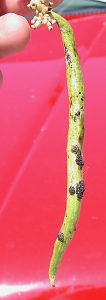Staining is caused by caterpillar frass and string-bean-like mite galls, not plant leaves or fruit. It doesn’t occur every year so there is no need to remove trees because of the staining.
In an attempt to reduce homeowner complaints and minimize potential of tree removal as a technique to eliminate the staining, we suggest, especially on Florida’s southeastern coast, abamectin trunk injections to reduce staining caused by the mite galls. For caterpillar suppression, primarily on Florida’s southwestern coast, dinotefuran soil drenches and acephate trunk injections as well as abamectin should be considered as options until more experience elucidates the best approach.
See research articles on different management (stain reduction) approaches here:
1/ Bucida 2016 FSHS Proc 246-248 pp
2/ Bucida caterpillar and gall management 2017. Florida Entomologist.
Also, see our Youtube video on this: https://www.youtube.com/watch?v=otBBJjkOXQ0
The “black olive” caterpillar has a local common name, the “bungee caterpillar” as the larvae will dangle from their webbing (left photo) and achieve “annoyance” status by getting into people’s he face or hair. Photo on right is black cardboard waved beneath a bucida tree canopy exploding with bungee caterpillars.
A Bucida buceras (black olive) tree severely infested by the flower gall mite.
 The mite flower galls resemble green beans. They can be 4 to 12 inches long. Note the brown patches of dark brown frass. This gall was tunneled into by the caterpillars. Both the gall alone or the caterpillar frass can cause significant staining probably due to concentrated bucida tannins.
The mite flower galls resemble green beans. They can be 4 to 12 inches long. Note the brown patches of dark brown frass. This gall was tunneled into by the caterpillars. Both the gall alone or the caterpillar frass can cause significant staining probably due to concentrated bucida tannins.
.
 1
1




